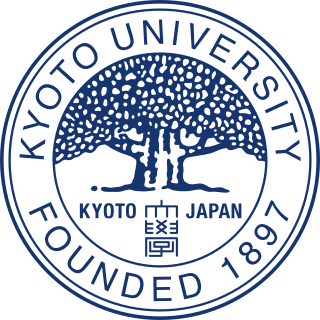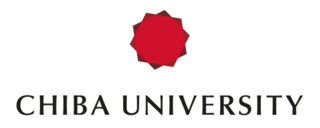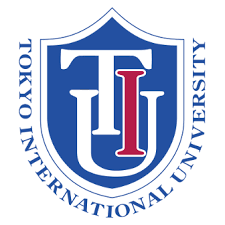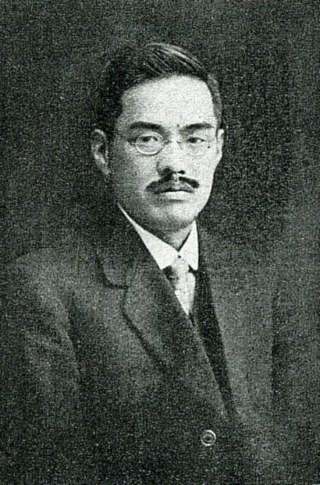
The University of Tokyo is a public research university in Bunkyō, Tokyo, Japan. Founded in 1877 as the nation's first modern university by the merger of several pre-westernisation era institutions, its direct precursors include the Tenmongata, founded in 1684, and the Shoheizaka Institute.

Kyoto University, or KyotoU, is a national research university located in Kyoto, Japan. Founded in 1897, it is one of the former Imperial Universities and the second oldest university in Japan.

Waseda University (早稲田大学), abbreviated as Waseda (早稲田) or Sōdai (早大), is a private research university in Shinjuku, Tokyo. Founded in 1882 as the Tōkyō Professional School by Ōkuma Shigenobu, the fifth Prime Minister of Japan, the school was formally renamed Waseda University in 1902.

Nihon University, abbreviated as Nichidai (日大), is a private research university in Japan. Its predecessor, Nihon Law School, was founded by Yamada Akiyoshi, the Minister of Justice, in 1889. The university's name is derived from the Japanese word "Nihon" meaning Japan. Nihon University now has "16 colleges and 87 departments, 20 postgraduate schools, 1 junior college which is composed of 5 departments, 1 correspondence division, 32 research institutes and 3 hospitals." The number of students exceeds 70,000 and is the largest in Japan.

The Tokyo Institute of Technology (東京工業大学) was a public university in Meguro, Tokyo, Japan. It merged with Tokyo Medical and Dental University to form the Institute of Science Tokyo on 1 October 2024.

Osaka University, abbreviated as OU or Handai (阪大), is a national research university in Osaka, Japan. The university traces its roots back to Edo-era institutions Tekijuku (1838) and Kaitokudo (1724), and was officially established in 1931 as the sixth of the Imperial Universities in Japan, with two faculties: science and medicine. Following the post-war educational reform, it merged with three pre-war higher schools, reorganizing as a comprehensive university with five faculties: science, medicine, letters, law and economics, and engineering. After the merger with Osaka University of Foreign Studies in 2007, Osaka University became the largest national university in Japan by undergraduate enrollment.

Chiba University is a national university in the city of Chiba, Japan. It offers Doctoral degrees in education as part of a coalition with Tokyo Gakugei University, Saitama University, and Yokohama National University. The university was formed in 1949 from existing educational institutions in Chiba Prefecture, and over a period of years absorbed Chiba Medical University (1923–1960), a preparatory department of the Tokyo Medical and Dental University, Chiba Normal School (1872–1951), Tokyo Polytechnic High School (1914–1951), Chiba Horticultural High School, among others. Chiba University was reincorporated in 2010 under the National University Corporation Act. Chiba University has been ranked 168th on the Asia University Rankings 2019 Top 100 by "The Times Higher Education". Its abbreviated form is Chibadai (千葉大).

Chuo University, commonly referred to as Chuo (中央) or Chu-Dai (中大), is a private research university in Hachioji, Tokyo, Japan. The univesity finds its roots in an school called Igirisu Hōritsu Gakkō, which was founded in 1885, and became a university in 1920. The university operates four campuses in Tokyo: the largest in Hachiōji, one in Bunkyō, and two others in Shinjuku. Chuo is organized into six faculties, ten graduate schools, and nine research institutes. There are also four affiliated high schools and two affiliated junior high schools.

The University of Tsukuba is a national research university located in Tsukuba, Ibaraki, Japan.
The University of Tokyo Library is a term used to refer to the University of Tokyo (UTokyo) Library System, which consists of three comprehensive libraries located in each of the university's main campuses, and 27 field-specific libraries affiliated with faculties and institutes within UTokyo. As of March 2024, the UTokyo Library System owns a collection of over 10 million books and numerous materials of historical or scientific values, making it the second largest library in Japan. It is only surpassed by the National Diet Library, which stores approximately 12.11 million books.

Tokyo International University (TIU) (東京国際大学, Tōkyō Kokusai Daigaku) is a private, research-oriented liberal arts university which was founded in 1965. Its main campus is located in Toshima, Tokyo, where it moved from its original location in Kawagoe, Saitama Prefecture.

The Komaba Campus, University of Tokyo is one of the three main Tokyo campuses of the University of Tokyo. It is divided into two sections; Komaba I and II. The former is home to the College of Arts and Sciences, the Department of Mathematics of the Faculty of Science, and their affiliated graduate school. The latter does not offer undergraduate programmes and is mainly used by the Research Centre for Advanced Science and Technology (RCAST) and the Institute of Industrial Science (IIS).

Chiba Institute of Technology is a private university in Narashino, Chiba, Japan. Abbreviated as Chiba kōdai, Chiba kō, kōdai, sen kōdai.

Yoshikazu Uchida was a Japanese architect and structural engineer. He designed many buildings on the campus of the University of Tokyo, and served as the 14th president of the university.
The campus of the University of Tokyo is the location of the first modern Japanese university. The campus is of historical note for two reasons. First, it was not damaged by air raids during World War II. Second, many university buildings have been declared National Treasures of Japan as they are examples of historic architectural design. This article focuses on registered cultural heritage.
Kyushu University in Fukuoka, Japan, was established as Fukuoka Medical College in 1903, which was affiliated with Kyoto Imperial University. Kyushu Imperial University was founded in 1911. In 1947, after World War II ended, the university changed its name to Kyushu University. The university is composed of six campuses: Chikushi, Hospital, Ito, Ohashi, Hakozaki, and Beppu. There are numerous historic buildings dating back to the many phases of history the university has seen. The Third Residential Complex on-campus has a western-style design and is reserved for foreign students. The complex dates back to 1924 and has been designated as a Municipal Cultural Property.

Komaba (駒場) is a residential neighborhood in the northern area of Meguro, Tokyo, Japan. Consisting of four districts, the neighborhood has a population of 6,847.

Teruo Fujii is a Japanese professor of Engineering and Applied Microfluidic Systems in University of Tokyo, and since 2007 as a professor at the Institute of Industrial Science (IIS) of the university has been conducting research on Microfluidics.[a] He received his Ph.D. in engineering from the University of Tokyo (1993). Fujii was also co-director of LIMMS-CNRS/IIS, a joint research lab between CNRS, France, and IIS, from 2007 to 2014. He served as the President of The Chemical and Biological Microsystems Society(CBMS).
The Kashiwa Campus, University of Tokyo is one of the three main campuses of the University of Tokyo located in Kashiwa, Chiba. It is also referred to as the "Kashiwa Campus" or simply "Kashiwa District". It consists of three subareas divided by parks and roads: Kashiwa, Kashiwa II, and Kashiwanoha Station Front.

The College of Arts and Sciences is one of the ten undergraduate faculties of the University of Tokyo and the only one referred to as a college. The Graduate School of Arts and Sciences is the postgraduate and research school attached to it. Originally, the college was a university preparatory boarding school called the First Higher School until 1950, and it still operates on the Komaba Campus, which used to belong to the higher school and is separate from the rest of the university. Hence, the word Komaba is synonymous with the College of Arts and Sciences within the university.


















